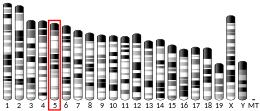| SEMA3C |
|---|
|
| Identifiers |
|---|
| Aliases | SEMA3C, SEMAE, SemE, semaphorin 3C |
|---|
| External IDs | OMIM: 602645; MGI: 107557; HomoloGene: 36201; GeneCards: SEMA3C; OMA:SEMA3C - orthologs |
|---|
| Gene location (Human) |
|---|
 | | Chr. | Chromosome 7 (human)[1] |
|---|
| | Band | 7q21.11 | Start | 80,742,538 bp[1] |
|---|
| End | 80,922,359 bp[1] |
|---|
|
| Gene location (Mouse) |
|---|
 | | Chr. | Chromosome 5 (mouse)[2] |
|---|
| | Band | 5|5 A3 | Start | 17,779,279 bp[2] |
|---|
| End | 17,935,266 bp[2] |
|---|
|
| RNA expression pattern |
|---|
| Bgee | | Human | Mouse (ortholog) |
|---|
| Top expressed in | - lactiferous duct
- synovial joint
- Achilles tendon
- cartilage tissue
- germinal epithelium
- skin of hip
- vena cava
- synovial membrane
- tail of epididymis
- biceps brachii
|
| | Top expressed in | - retinal pigment epithelium
- right lung lobe
- submandibular gland
- ankle
- medullary collecting duct
- left colon
- calvaria
- skin of external ear
- vas deferens
- seminal vesicula
|
| | More reference expression data |
|
|---|
| BioGPS | 
 | | More reference expression data |
|
|---|
|
| Gene ontology |
|---|
| Molecular function | - semaphorin receptor binding
- neuropilin binding
- chemorepellent activity
| | Cellular component | - extracellular region
- extracellular exosome
- extracellular space
- integral component of plasma membrane
| | Biological process | - somitogenesis
- cell differentiation
- limb bud formation
- outflow tract morphogenesis
- post-embryonic development
- nervous system development
- axon guidance
- multicellular organism development
- heart development
- blood vessel remodeling
- pulmonary myocardium development
- immune response
- neural tube development
- dichotomous subdivision of terminal units involved in salivary gland branching
- cardiac right ventricle morphogenesis
- neural crest cell migration
- negative chemotaxis
- outflow tract septum morphogenesis
- semaphorin-plexin signaling pathway
- cardiac endothelial to mesenchymal transition
- positive regulation of cardiac neural crest cell migration involved in outflow tract morphogenesis
- positive regulation of cell migration
- negative regulation of axon extension involved in axon guidance
| | Sources:Amigo / QuickGO |
|
| Orthologs |
|---|
| Species | Human | Mouse |
|---|
| Entrez | | |
|---|
| Ensembl | | |
|---|
| UniProt | | |
|---|
| RefSeq (mRNA) | |
|---|
NM_006379
NM_001350120
NM_001350121 |
| |
|---|
| RefSeq (protein) | |
|---|
NP_006370
NP_001337049
NP_001337050 |
| |
|---|
| Location (UCSC) | Chr 7: 80.74 – 80.92 Mb | Chr 5: 17.78 – 17.94 Mb |
|---|
| PubMed search | [3] | [4] |
|---|
|
| Wikidata |
| View/Edit Human | View/Edit Mouse |
|


















